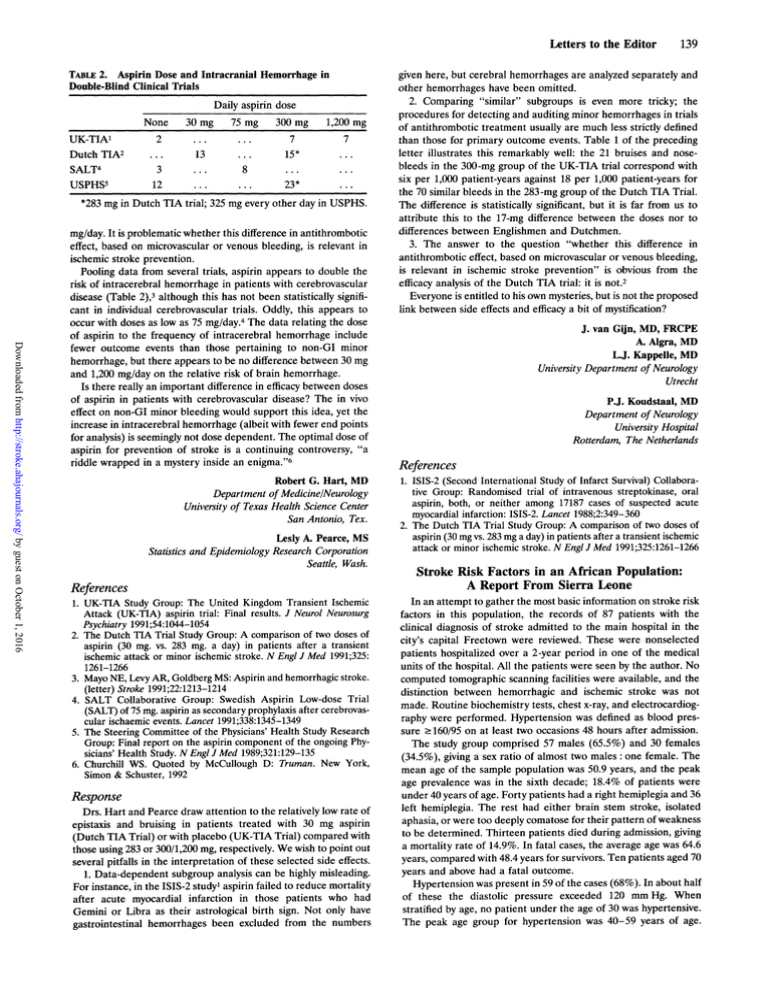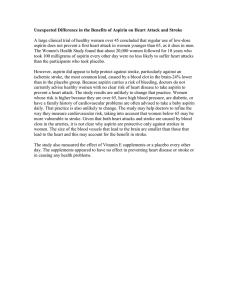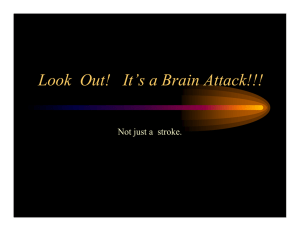
Letters to the Editor
TABLE 2. Aspirin Dose and Intracranial Hemorrhage in
Double-Blind Clinical Trials
Daily aspirin dose
75 mg 300 mg 1,200 mg
7
...
7
UK-TIA'
...
15*
Dutch TIA2
8
...
SALT4
23*
...
USPHS'
*283 mg in Dutch TIA trial; 325 mg every other day in USPHS.
None
2
...
3
12
30 mg
...
13
...
...
Downloaded from http://stroke.ahajournals.org/ by guest on October 1, 2016
mg/day. It is problematic whether this difference in antithrombotic
effect, based on microvascular or venous bleeding, is relevant in
ischemic stroke prevention.
Pooling data from several trials, aspirin appears to double the
risk of intracerebral hemorrhage in patients with cerebrovascular
disease (Table 2),3 although this has not been statistically significant in individual cerebrovascular trials. Oddly, this appears to
occur with doses as low as 75 mg/day.4 The data relating the dose
of aspirin to the frequency of intracerebral hemorrhage include
fewer outcome events than those pertaining to non-GI minor
hemorrhage, but there appears to be no difference between 30 mg
and 1,200 mg/day on the relative risk of brain hemorrhage.
Is there really an important difference in efficacy between doses
of aspirin in patients with cerebrovascular disease? The in vivo
effect on non-GI minor bleeding would support this idea, yet the
increase in intracerebral hemorrhage (albeit with fewer end points
for analysis) is seemingly not dose dependent. The optimal dose of
aspirin for prevention of stroke is a continuing controversy, "a
riddle wrapped in a mystery inside an enigma."6
Robert G. Hart, MD
Department of Medicine/Neurology
University of Texas Health Science Center
San Antonio, Tex.
Lesly A. Pearce, MS
Statistics and Epidemiology Research Corporation
Seattle, Wash.
References
1. UK-TIA Study Group: The United Kingdom Transient Ischemic
Attack (UK-TIA) aspirin trial: Final results. J Neurol Neurosurg
Psychiatry 1991;54:1044-1054
2. The Dutch TIA Trial Study Group: A comparison of two doses of
aspirin (30 mg. vs. 283 mg. a day) in patients after a transient
ischemic attack or minor ischemic stroke. N Engl J Med 1991;325:
1261-1266
3. Mayo NE, Levy AR, Goldberg MS: Aspirin and hemorrhagic stroke.
(letter) Stroke 1991;22:1213-1214
4. SALT Collaborative Group: Swedish Aspirin Low-dose Trial
(SALT) of 75 mg. aspirin as secondary prophylaxis after cerebrovascular ischaemic events. Lancet 1991;338:1345-1349
5. The Steering Committee of the Physicians' Health Study Research
Group: Final report on the aspirin component of the ongoing Physicians' Health Study. N Engl J Med 1989;321:129-135
6. Churchill WS. Quoted by McCullough D: Truman. New York,
Simon & Schuster, 1992
Response
Drs. Hart and Pearce draw attention to the relatively low rate of
epistaxis and bruising in patients treated with 30 mg aspirin
(Dutch TIA Trial) or with placebo (UK-TIA Trial) compared with
those using 283 or 300/1,200 mg, respectively. We wish to point out
several pitfalls in the interpretation of these selected side effects.
1. Data-dependent subgroup analysis can be highly misleading.
For instance, in the ISIS-2 study' aspirin failed to reduce mortality
after acute myocardial infarction in those patients who had
Gemini or Libra as their astrological birth sign. Not only have
gastrointestinal hemorrhages
been excluded from the numbers
1;39
given here, but cerebral hemorrhages are analyzed separately and
other hemorrhages have been omitted.
2. Comparing "similar" subgroups is even more tricky; the
procedures for detecting and auditing minor hemorrhages in trials
of antithrombotic treatment usually are much less strictly defined
than those for primary outcome events. Table 1 of the preceding
letter illustrates this remarkably well: the 21 bruises and nosebleeds in the 300-mg group of the UK-TIA trial correspond with
six per 1,000 patient-years against 18 per 1,000 patient-years for
the 70 similar bleeds in the 283-mg group of the Dutch TIA Trial.
The difference is statistically significant, but it is far from us to
attribute this to the 17-mg difference between the doses nor to
differences between Englishmen and Dutchmen.
3. The answer to the question "whether this difference in
antithrombotic effect, based on microvascular or venous bleeding,
is relevant in ischemic stroke prevention" is obvious from the
efficacy analysis of the Dutch TIA trial: it is not.2
Everyone is entitled to his own mysteries, but is not the proposed
link between side effects and efficacy a bit of mystification?
J. van Gijn, MD, FRCPE
A£ Algra, MD
LJ. Kappelle, MD
University Department of Neurology
Utrecht
P.J. Koudstaal, MD
Department of Neurology
University Hospital
Rotterdam, The Netherlands
References
1. ISIS-2 (Second International Study of Infarct Survival) Collaborative Group: Randomised trial of intravenous streptokinase, oral
aspirin, both, or neither among 17187 cases of suspected acute
myocardial infarction: ISIS-2. Lancet 1988;2:349-360
2. The Dutch TIA Trial Study Group: A comparison of two doses of
aspirin (30 mg vs. 283 mg a day) in patients after a transient ischemic
attack or minor ischemic stroke. N Engl J Med 1991;325:1261-1266
Stroke Risk Factors in an African Population:
A Report From Sierra Leone
In an attempt to gather the most basic information on stroke risk
factors in this population, the records of 87 patients with the
clinical diagnosis of stroke admitted to the main hospital in the
city's capital Freetown were reviewed. These were nonselected
patients hospitalized over a 2-year period in one of the medical
units of the hospital. All the patients were seen by the author. No
computed tomographic scanning facilities were available, and the
distinction between hemorrhagic and ischemic stroke was not
made. Routine biochemistry tests, chest x-ray, and electrocardiography were performed. Hypertension was defined as blood pressure >160/95 on at least two occasions 48 hours after admission.
The study group comprised 57 males (65.5%) and 30 females
(34.5%), giving a sex ratio of almost two males: one female. The
mean age of the sample population was 50.9 years, and the peak
age prevalence was in the sixth decade; 18.4% of patients were
under 40 years of age. Forty patients had a right hemiplegia and 36
left hemiplegia. The rest had either brain stem stroke, isolated
aphasia, or were too deeply comatose for their pattern of weakness
to be determined. Thirteen patients died during admission, giving
a mortality rate of 14.9%. In fatal cases, the average age was 64.6
years, compared with 48.4 years fur survivors. Ten patients aged 70
years and above had a fatal outcome.
Hypertension was present in 59 of the cases (68%). In about half
of these the diastolic pressure exceeded 120 mm Hg. When
stratified by age, no patient under the age of 30 was hypertensive.
The peak age group for hypertension was 40-59 years of age.
Stroke risk factors in an African population: a report from Sierra Leone.
D R Lisk
Downloaded from http://stroke.ahajournals.org/ by guest on October 1, 2016
Stroke. 1993;24:139-141
doi: 10.1161/01.STR.24.1.139
Stroke is published by the American Heart Association, 7272 Greenville Avenue, Dallas, TX 75231
Copyright © 1993 American Heart Association, Inc. All rights reserved.
Print ISSN: 0039-2499. Online ISSN: 1524-4628
The online version of this article, along with updated information and services, is located on the
World Wide Web at:
http://stroke.ahajournals.org/content/24/1/139.citation
Permissions: Requests for permissions to reproduce figures, tables, or portions of articles originally published
in Stroke can be obtained via RightsLink, a service of the Copyright Clearance Center, not the Editorial Office.
Once the online version of the published article for which permission is being requested is located, click
Request Permissions in the middle column of the Web page under Services. Further information about this
process is available in the Permissions and Rights Question and Answer document.
Reprints: Information about reprints can be found online at:
http://www.lww.com/reprints
Subscriptions: Information about subscribing to Stroke is online at:
http://stroke.ahajournals.org//subscriptions/





